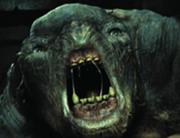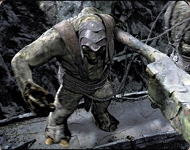| This article is about race. For other uses, see Troll (disambiguation). |
Trolls were a race of large humanoid creatures of limited intellect. They were strong and vicious, but some of them could not endure sunlight and turned to stone when exposed to it, which rendered them permanently lifeless.[2]
History
First Age
Morgoth evidently[3] corrupted[3] Trolls from "primitive human types"[3] during the First Age in the "twilight of the Elder Days". The exact nature of their origins and corruption is unclear, though Treebeard believed that Trolls were made by the Dark Lord "in mockery of Ents", similar to the belief that Orcs were a twisted parody of the Elves.[4] Whatever their exact origins were, Trolls were dull and lumpish, and at least in their beginning, were as inarticulate as animals.[5]
The participation of Trolls in the War of the Great Jewels was not recorded in the tales of the Elder Days until the year 472 when the Battle of Unnumbered Tears took place.[6] The hosts of Angband attacked and killed all of the rearguard of the brothers Húrin and Huor and the remnant of the Men of the House of Hador from Dor-lómin except Húrin at the river Rivil. When Húrin was the last man standing, he threw away his shield and gripped his axe with both hands. A song tells that his axe smoked in the black blood of the troll-guard of Gothmog, the Lord of Balrogs. This blood apparently melted his axe, allowing Orcs to swarm over him. He was soon bound by Gothmog and dragged to Angband.[7]
According to the Lay of Lúthien that was written in the Havens of Sirion between the years 503[8] and 538,[9] it was said that as Beren and Lúthien descended into the depths of Angband, they saw "huge shapes…like carven trolls…hewn of blasted rock" that seemed to mock the likeness of Men.[10]
Second and Third Ages
Later on, Sauron taught them the little that they were able to learn and increased their intelligence with wickedness. As a consequence, the Trolls learned as much language as they could from the Orcs. In the West-lands, Stone-trolls spoke a debased form of Westron. The Olog-hai spoke only the Black Speech of Barad-dûr.[5]
Since days before memory Trolls settled in the north of the Misty Mountains, in particular near the Ettenmoors. The Witch-realm of Angmar was founded in their area, and while it lasted, the Trolls' numbers increased, as did their wickedness. After the fall of Angmar, the Trolls retreated to the east of the Misty Mountains, but three-hundred years before the War of the Ring they returned to Eriador. They managed to make dens in the hills as far west as the North Downs despite the efforts of the Rangers of the North to watch the area.[11]
During the Long Winter that lay upon the fields of Rohan in the years 2758 and 2759 of the Third Age, Helm Hammerhand clad himself in white and stalked the camps of the Dunlendings "like a snow-troll" and killed many with seemingly his bare hands. Helm's deeds were long remembered in Dunland as a legend and struck fear and hatred into any who heard it. The tale was later included in the Red Book of Westmarch.[12][13]
In the time of Arador, a band of hill-trolls threatened his house in the woods near the river Hoarwell north of the Trollshaws.[14] In the year 2930,[15] these hill-trolls captured Arador in the north of Rivendell and killed him.[11]
In the late Third Age, Sauron bred a new race of Trolls, which were called Olog-hai in the Black Speech. How this was done is untold, but it was believed by some that Sauron bred Trolls with giant Orcs to accomplish this.[16] In contrast to the older race of Trolls from the First Age, the Olog-hai could bear exposure to sunlight as long as they were controlled by the will of Sauron. They were cunning, strong, agile, fierce, harder than stone, and spoke little. The Olog-hai were first seen at the end of the Third Age in Southern Mirkwood and in the mountain borders of Mordor.[5]
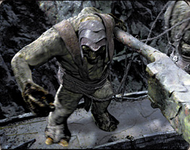
In the year 2941,[15] Thorin and Company encountered William Huggins, Bert, and Tom. These Stone-trolls had come down from the mountains and eaten some sheep as well as a number of Men equivalent to a village and a half.[17]
The Trolls captured Bilbo Baggins and the Dwarves, but Gandalf returned in time to keep the Trolls go on arguing how to cook the Dwarves by impersonating the voices of the Trolls from a place of hiding until the first lights of the morning sun came over the Troll Ridge[18] and turned the Trolls to stone. Afterwards Thorin and Company discovered the Trolls' lair[19] and took the swords Glamdring and Orcrist, the knife Sting, gold coins, and food.[17]
It is not known how the Trolls had gotten the swords, but Elrond guessed that the Trolls had robbed other robbers or had found them in a hold in the mountains as remnants of old robberies.[20]
When the fiftieth birthday of Frodo Baggins was getting near, probably early in the year 3018[21] rumors had reached The Shire that Trolls were abroad, more cunning than normal and armed with dreadful weapons.[22] By the year 3018 when Aragorn II and the Hobbits were attacked on Weathertop[21] the land east of Weathertop was uninhabited and had been deserted, because Trolls sometimes came down from the northern valleys of the Misty Mountains.[23] At that time, Trolls still lived in the Ettendales,[2] the valleys of the Ettenmoors.[24]
On October 18 of the year 3018, Aragorn II, along with Frodo Baggins, Samwise Gamgee, Meriadoc Brandybuck, and Peregrin Took found a path in the Trollshaws, which had probably been made by the three Trolls, followed it and discovered that it led to the Trolls' lair and then on to the clearing in the woods where the three trolls that had been turned to stone still stood.[2]
On January 15 of the year TA 3019,[25][21] the Fellowship of the Ring was attacked in the Chamber of Mazarbul in Moria by various Orcs alongside one or more cave-trolls that Gandalf had seen in the passage outside. The huge arm and shoulder that appeared in the gap in the barred door of the chamber presumably belonged to this cave-troll[26]. When Boromir hewed at the arm, his sword recoiled. However, the Troll retreated when Frodo stabbed it in the foot with Sting, causing black blood to drip from the blade onto the floor and smoke there. Later during the flight of the fellowship through Moria, two Trolls appeared in the Second Hall of Moria, but it is not untold whether they were cave-trolls.[27]
In the early hours of the Siege of Gondor on March 15 in the year 3019,[21] mountain-trolls were used by Sauron alongside great siege beasts to help move the battering ram Grond to Minas Tirith's Great Gate and swung Grond four times against the gate until it broke.[28]
During the Battle of the Pelennor Fields, a group of Men from Far Harad who fought for the Dark Lord Sauron were likened to half-trolls or troll-men. These Men had black skin, white eyes, and red tongues. They fought under the command of Gothmog, and were sent out to fight alongside a group of "Easterlings with axes", some "Southrons in scarlet", and the "Variags of Khand". The half-trolls were later driven out of the Pelennor Fields by the Swan-knights of Dol Amroth along with many Orcs and Variags.[29]
On March 25 in the year 3019,[21] at the beginning of the Battle of the Morannon the Host of the West was attacked on the Slag-hills before the Black Gate by "a great company of hill-trolls" from Gorgoroth with huge round bucklers and heavy hammers. Peregrin Took killed the chief of the Trolls with his Barrow-blade when the troll tried to bite the throat of Beregond.[30]
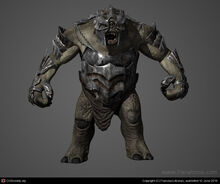
Legacy
While it is unknown what happened to Trolls after the Downfall of Barad-dûr, the Hobbit Samwise Gamgee composed two poems that had Trolls in them.[31] The first one, called The Stone Troll,[32] was recited by Samwise Gamgee to Aragorn II, Frodo, Merry, and Pippin during their stay near the Troll Ridge[18].[2] The second poem, called Perry-the-Winkle, also composed by Sam,[31] featured a Lonely Troll as the protagonist. However, unlike other Trolls, the Lonely Troll was friendly and good-natured.[33]
Physiology & characteristics
- "Yes, I am afraid trolls do behave like that, even those with only one head each."
- —Roast Mutton
Trolls were taller and broader than Men[30] with a height of twelve feet or more.[1] They had dark skin with greenish scales, large flat toeless feet,[27] and knotted hands with claws.[30] Their blood was black.[27][30][7]
Some Trolls might have had more than one head, which is fleetingly suggested in The Hobbit, commenting on William Huggins wiping his lips on his sleeve.[17] If this statement was not merely a way of speaking, perhaps there were indeed Trolls in Middle-earth that, unlike the Stone-trolls, had more than one head and behaved even worse.
Regular Trolls turned back to stone from which they had been created when exposed to the sunlight,[17] but the Trolls known as Olog-hai could tolerate sunlight as long as they were controlled by the will of Sauron.[5]
Trolls lived in different terrains and were known as cave-trolls,[27] hill-trolls,[30], or mountain-trolls.[28] They did not build buildings, but slept in caves or holes instead.[2] It is possible that the term Stone-trolls[5] was used for regular Trolls who turned back to stone when exposed to the sunlight.[34] This is also suggested by the use of the term Stone-trolls before the paragraph about the Olog-hai, which could endure sunlight.
During the Battle of the Pelennor Fields, there is a reference to "men like half-trolls", also called Troll-men, but it is unclear whether these men actually had some trollish ancestry or were simply compared to trolls (for some readers, the first interpretation is supported by the similar and interchangeable terms "orc-men" and "half-orcs", referring to crossbreeds of Saruman). According to Christopher Tolkien, a character in the Thiðrekssaga (a 13th century work which influenced The Legend of Sigurd and Gudrún) who is an off-spring of a woman and an incubus, appears "troll-like" and is "all over dark, with black hair and black beard".[35]
Types
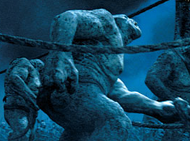
Etymology
The Sindarin word for a "troll" is torog.[5] The Black Speech equivalent is olog.[36]
The name Rhudaur is translated by Tolkien as "Troll shaw", with rhû translated as "evil, wicked".[37]
In an early chart of different creatures, Trolls are given the Qenya name maulir. Patrick Howard Wynne and Christopher John Gilson have suggested that maulir is possibly related to the Qenya word maule ("crying, weeping"), and thus perhaps "referring to cries made by these monsters or to the weeping of their victims".[38]
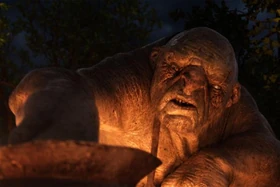
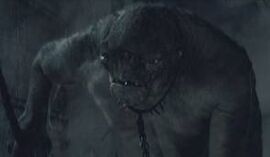
Inspiration
Trolls were originally a part of the Norse mythology (as a negative synonym for jötunn and "giants") and Scandinavian folklore (as ugly, large creatures of remote wildlife areas). J.R.R. Tolkien used elements of old barbarous myth-making that Trolls returned to stone when they were not in the dark.[34]
Helen Buckhurst, a friend and colleague of J.R.R. Tolkien presented a paper titled Icelandic Folklore in 1926 in which she stated that Icelandic Trolls in the Sagas and in more recent tales were huge, mishappen, and ugly creatures who generally lived in caves in the mountains, were almost always evil, and often raided outlying farms at night to take sheep, horses, children, men, and women and ate them in their homes in the mountains. She also mentioned that some kinds of Trolls must stay in caves during the day, because the light of the sun turns them to stone.[39][40]
Commenting on the possibility of Trolls having more than one head, John D. Rateliff has noted that trolls "with multiple heads appear in many stories", especially pointing to George Webbe Dasent's "Soria Moria Castle".[41] C.S. Lewis mentioned the Ettins of Ettinsmoor in Narnia, some of which have two heads.[42] In many later fantasy settings, but also some adaptations of Middle-earth, there are two-headed monsters, which usually are called Ettens.
In other writings
Tolkien translated the word word wodwos as "wood-trolls" in Sir Gawain and the Green Knight.[43]
In adaptations
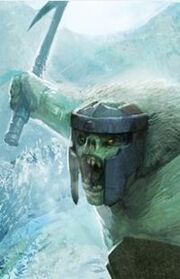
In J.R.R. Tolkien's The Hobbit (1967)
In J.R.R. Tolkien's The Hobbit in 1967, the three Trolls' position in the narrative was taken by two creatures called Groans.[44] They had wooden, bark-like skin, and, instead of stone, turned into dead trees when exposed to sunlight.
In Bakshi's animated film
Ralph Bakshi's 1978 The Lord of the Rings follows the book very faithfully in its depiction of the encounter with the troll in the Chamber of Mazarbul; however, the troll does have toes here. From the parts of it seen through the door it seems to be a humanoid reptilian around nine feet tall. Tolkien described the troll's foot as flat and toeless. There are no other trolls.
In Rankin and Bass animated films
Trolls here are shown as large humanoids of apparently mammalian nature, with large noses, tails with fur tips, and tusks (though Tom's have apparently been broken off in his mouth). Other than Tom, Bert, and William, several trolls in armor are seen in the Siege of Gondor in The Return of the King, as melee fighters and as operators of the battering ram Grond.
In The Lord of the Rings film trilogy
In Peter Jackson's 2001 The Fellowship of the Ring, there is also only one cave-troll. Boromir first sights it; it later barges through the open doors, and smashes much of the Chamber of Mazarbul, including Balin's tomb, in the ensuing fight. It stabs Frodo, who is saved by his Mithril shirt (in the book it is an Uruk captain who spears him). It is killed by the members of the Fellowship (though it puts up a good fight), who spear and hack at it until Legolas dispatches it with an arrow through the mouth and skull. It has been noted that, in Jackson's version, light from a window falls on Balin's tomb, which the troll steps into. This theoretically should have turned it to stone, although the light may be coming from the moon during early morning hours.

Battle trolls are shown in The Two Towers and The Return of the King, sporting armor and spiked clubs alluded to in the appendices. They are seen at the Siege of Gondor, as primary shock troops entering Minas Tirith when Grond has broken its Gate. At least one survived, which carried a hammer instead of a club, and is seen later, attempting to break down a gate.
Sauron's military used other trolls for moving extremely heavy objects such as gates and siege towers, sometimes chaining them. The cave troll in Moria wore a collar with a trailing chain, suggesting it may have been a former labourer, though this particular specimen was undisciplined enough to attack some of its own allies in the fight, thus perhaps showing others' need to restrain it.
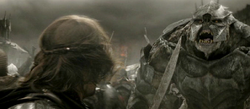
Aragorn fights one of the Olog-hai during the Battle of the Black Gate. This Olog's entire upper body is covered in black plate armour. While most trolls in the movies wielded clubs, this one wielded a sword as well as a briefly-seen mace. It fled when the Ring was destroyed, and was last seen running past the ranks of Sauron's army before the ground collapsed beneath them.
In The Hobbit film trilogy
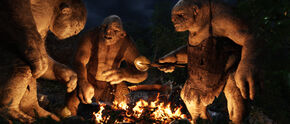
In The Hobbit: An Unexpected Journey, Stone-trolls known as Tom, Bert, and William are encountered by Bilbo, Fíli and Kíli after having stolen several of the Dwarves' ponies. Fíli and Kíli stay back, while Bilbo tries to steal a blade from the trolls to cut the ponies free. When Bilbo is caught accidentally by the trolls, the Dwarves charge them and a small skirmish ensues as Bilbo tries to free the ponies. However, Bilbo is caught, and when the trolls threaten to tear Bilbo apart, the Dwarves surrender and are put into sacks. Half of the Dwarves are put onto the spit to be cooked over the fire, while the others, including Thorin, along with Bilbo, are left on the ground in their sacks. Bilbo spots Gandalf sneaking around, and begins to discuss with the trolls ways of cooking dwarf in order to buy time. As this plan starts to fail as Tom attempts to eat Bombur raw, Bilbo quickly states the Dwarves are infested with intestinal parasites to try to stop the trolls from eating them, but they do not get easily fooled, especially William. Then Gandalf appears, and as the trolls curiously wonder who he is (and if he can be eaten), the wizard using his staff splits a rock that was shielding the trolls from the sun's light as it rises, turning them to stone. After the company was set free, Thorin and Gandalf reflect that the trolls never ventured this far south from the Ettenmoors since the Second Age, when a darker power ruled the lands.
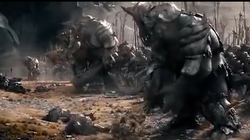
In Peter Jackson's 2014 The Hobbit: The Battle of the Five Armies, Azog's Orc army is bolstered by a few dozen colossal "Guldur Olog-hai". Some act as siege beasts and carry catapults or similar equipment, while others are used primarily as battle trolls, and are clad in partial plate armor as well as being given cruel weapons such as maces, clubs, and scythed gauntlets. In the fight for the Lonely Mountain, they are seen engaging the allied armies of Dwarves, Elves, and Lake-men in both the large valley of Erebor and the ruined streets of Dale. Most of these trolls stand at about 25–30 feet tall, though a few are smaller, at around the 9–12 foot tall range.

A large, truncated, albino Olog-hai with multiple prosthetics (who was nicknamed Stumpy by the producers) is killed by Legolas during the later portions of the battle. In the Extended Edition of the film, he is first seen in an earlier scene where he is commandeered by Bofur in an effort to fight against the Guldur Orcs and other War Trolls.
In games
In the 1982-97 Middle-earth Role Playing game, an individual monster called a Skessa, a cross-breed between a troll and a giant, has two heads.[45]
In the 1995-8 Middle-earth Collectible Card Game, a "'Two-headed' Troll" is a Warrior Ally for evil players.
In the 1998-2004 Middle-earth Online, Ettins were a race of two-headed trolls that were intended to be included in the game.[46]
In the 2002-5: The Lord of the Rings Roleplaying Game, Ettens resemble hill-trolls, but possess "not one but two long heads". The solitary creatures, a result of an ancient experiment by Morgoth, live almost exclusively in the Ettenmoors.[47]
In J.R.R. Tolkien's The Lord of the Rings, Volume 1 (1994) SNES, the player can fight Trolls with a sword, dagger or axe. They appear in green and blue palettes, and are the most dangerous enemies.
In The Lord of the Rings: The Fellowship of the Ring (2002), the player can fight trolls as Aragorn or Gandalf.
In The Hobbit: The Prelude to The Lord of the Rings (2003), In addition to the three Stone-trolls from the book, a Cave-troll was intended to appear during the "Over Hill and Under Hill" level in the PC and console versions, where it would have served as the level's boss. Even though the encounter was cut from the final version of the game, Bilbo still mentions the troll to Gandalf when he reunites with Thorin and Company, and Kili informs Bilbo that Trolls are known to live in the Misty Mountains, and hopes Bilbo didn't encounter any while he was separated.[48] Third-party trainer programs for the PC version allow the boss battle to be reintegrated into the game. Like the three Stone-trolls, the Cave-troll would have been capable of speaking Westron, as shown during its introductory cutscene where it complains about having a toothache. Defeating it would have yielded the Troll Key which, in the final version of the game, instead lays on the floor for Bilbo to take without having to kill any of the creatures that guard it.
Various movie-only sources, like The Lord of the Rings: Weapons and Warfare, and the spin-off games by Electronic Arts, have expanded on what Tolkien described of trolls.
"Forest-trolls" were invented for Electronic Arts' The Lord of the Rings: The Two Towers which appear in several levels including "Fangorn Forest" and "Breached Wall". They have hard, grey skin, are resistant to arrow fire, and carry a large quiver of wood logs (to use as firewood and projectiles) and a mace.
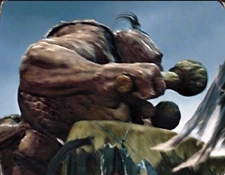
For EA's The Lord of the Rings: The Return of the King video game, trolls also returned as enemy units. Although they were slow, their attacks could not be blocked and were very strong; however, there was often a war pike around that made them easy to kill. They also appeared as enemies in "Lord of the Rings: The Third Age". In this game, they were again slow but powerful, and could take a lot of damage before dying. Some of the later trolls in the game (the Attack Troll) wielded a pair of large swords, while a stronger kind carried massive war hammers.
In the 2010 video game, The Lord of the Rings: Aragorn's Quest, Trolls appear as enemy units that Aragorn has to fight.
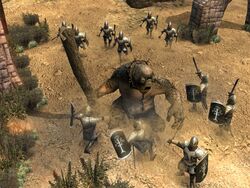
Trolls also appear as controllable units in The Lord of the Rings: The Battle for Middle-earth, its sequel, The Lord of the Rings: The Battle for Middle-earth II and its expansion The Rise of the Witch-king. In The Lord of the Rings: The Battle for Middle-earth, it is necessary for a regular mountain troll to gain a rank (after destroying enemy units, etc.), to become an attack troll, where it gains an armour bonus and can heal by itself as the only non-hero unit who is able to do so. In The Battle for Middle-earth II, attack trolls can be made from a Level 3 Troll Cage. In The Rise of the Witch-king, the Angmar faction has a troll hero named Rogash. Rogash was portrayed to be an apparently relatively intelligent hill-troll, seemingly serving as the Witch-king's key to power over the trolls. Rogash's authority over the trolls is displayed in his ability to convert other trolls on the battle field to the player's side. Rogash is a potent fighter who wears armor and wields a hefty sword. Mountain-trolls and Cave-trolls usually flail when dying in Battle for Middle-earth. In all the Battle for Middle-earth games, trolls serve as "tank" units, and Drummer Trolls who boost the stats of nearby infantry are also available.

Wood-trolls in the MMORPG The Lord of the Rings Online are trolls that appear to be semi-Entish and made of wood. They appear in the Trollshaws and Evendim, are particularly difficult to kill, and deal a lot of damage.
Middle-earth Strategy Battle Game, produced by Games Workshop, includes an Isengard troll, which is depicted as wearing armour and carrying a shield similar to Uruk-hai.
In Norse mythology, trolls are magical creatures with special skills, and are so accepted to this day in Norway. In Tolkien's writings, they are portrayed as evil, with crude, bloodthirsty habits.
In Middle-earth: Shadow of War, Olog-hai are introduced as a new type of enemy and potential nemesis. The Ologs are portrayed more closely to the sentient, if at times dull portrayal of the trolls from The Hobbit novel rather than the more bestial portrayals in Peter Jackson's The Hobbit and The Lord of the Rings film trilogies. The Ologs are capable of speech, with some speaking in broken sentences, others in complete sentences, and occasionally those who only speak in Black Speech. Like the Uruks, Ologs can become captains, warchiefs, or overlords, and can belong to one of the nine tribes present in the game. However, the game only refers to them as trolls rarely, and often instead mislabels them as orcs.
Gallery
Translations
| Foreign Language | Translated name |
|---|---|
| Amharic | ትሮሎች |
| Arabic | الترول |
| Belarusian Cyrillic | тролі |
| Bengali | ট্রলস |
| Bulgarian Cyrillic | Троловете |
| Chinese | 巨魔 / 食人妖 |
| Croatian | Trolovi |
| Czech | Trollové / Zlobři |
| Danish | Trolde |
| Dutch | Trollen |
| Finnish | Peikot |
| Georgian | ტროლები |
| German | Trolle |
| Greek | Τρολλς |
| Gujarati | વેતાળ |
| Hebrew | טרולים |
| Hungarian | Trollok |
| Italian | Troll / vagabondo / Uomini Neri |
| Kannada | ರಾಕ್ಷಸರು |
| Latvian | Troļļi |
| Persian | عضو شورای نظارت مدت |
| Polish | Trolle |
| Russian | Тролли |
| Slovak | Trollovia |
| Slovenian | Škrati |
| Spanish | Trols |
| Tamil | ட்ரால்ஸ் |
| Telugu | ట్రోలు |
| Turkish | Troller |
| Ukrainian Cyrillic | тролі |
| Yiddish | טראָללס |
| Races of Arda |
| Free Peoples of the World: |
| Ainur (Valar & Maiar) | Dwarves | Elves | Ents | Great Eagles | Hobbits | Huorns | Men | Petty-dwarves | Skin-changers (Beornings) |
| Servants of the Shadow: |
| Barrow-wights | Ettens | Dragons (Fire-drakes & Cold-drakes) | Ogres | Orcs (Uruk-hai) | Spiders | Trolls | Úmaiar (Balrogs) | Úvanimor | Vampires | Wargs | Werewolves | Wraiths |
References
- ↑ 1.0 1.1 The Lord of the Rings, vol. II: The Two Towers, Book Three, ch. VIII: "The Road to Isengard"
- ↑ 2.0 2.1 2.2 2.3 2.4 The Lord of the Rings, vol. I: The Fellowship of the Ring, Book One, ch. XII: "Flight to the Ford"
- ↑ 3.0 3.1 3.2 The History of Middle-earth, vol. X: Morgoth's Ring, Part Five: Myths Transformed, "[Text] IX", pg. 414
- ↑ The Lord of the Rings, vol. I: The Fellowship of the Ring, Book Three, ch. IV: "Treebeard"
- ↑ 5.0 5.1 5.2 5.3 5.4 5.5 The Lord of the Rings, Appendix F, "The Languages and Peoples of the Third Age", "Of Other Races"
- ↑ The History of Middle-earth, vol. XI: The War of the Jewels, Part One: The Grey Annals, "472", §240, pgs. 76-7
- ↑ 7.0 7.1 The Silmarillion, Quenta Silmarillion, ch. 20: "Of the Fifth Battle: Nirnaeth Arnoediad"
- ↑ Lay of Leithian (note 1) on The Encyclopedia of Arda
- ↑ Lay of Lúthien (note 1) on The Encyclopedia of Arda
- ↑ The History of Middle-earth, vol. III: The Lays of Beleriand', III: The Lay of Leithian, "Canto XIII (Beren and Lúthien in Angband)"
- ↑ 11.0 11.1 The Lord of the Rings, Appendix A: Annals of the Kings and Rulers, I: "The Númenórean Kings", "The Tale of Aragorn and Arwen"
- ↑ The Lord of the Rings, Appendix A, Annals of the Kings and Rulers, second paragraph ("Actual extracts from longer annals and tales are placed within quotation marks")
- ↑ The Lord of the Rings, Appendix A, Annals of the Kings and Rulers, II: "The House of Eorl", the entire section "Soon afterwards the Long Winter…line of mounds was begun." is in quotation marks
- ↑ The Nature of Middle-earth, Part Three: "The World, its Lands, and its Inhabitants: XVII: "Silvan Elves and Silvan Elvish", pg. 366 (note 12)
- ↑ 15.0 15.1 The Lord of the Rings, Appendix B, "The Third Age"
- ↑ The History of Middle-earth, vol. XII: The Peoples of Middle-earth, II: "The Appendix on Languages"
- ↑ 17.0 17.1 17.2 17.3 The Hobbit, ch. II: "Roast Mutton"
- ↑ 18.0 18.1 The Chronology of The Lord of the Rings, pg. 38
- ↑ The Hobbit, Chapter IV: "Over Hill and Under Hill"
- ↑ The Hobbit, ch. III: "A Short Rest"
- ↑ 21.0 21.1 21.2 21.3 21.4 The Lord of the Rings, Appendix B, "The Great Years"
- ↑ The Lord of the Rings, vol. I: The Fellowship of the Ring, Book One, ch. II: "The Shadow of the Past"
- ↑ The Lord of the Rings, vol. I: The Fellowship of the Ring, Book One, ch. XI: "A Knife in the Dark"
- ↑ The Lord of the Rings: A Reader's Companion, "Unfinished index for The Lord of the Rings", pg. 188 (entry Ettendales)
- ↑ The Lord of the Rings, vol. I: The Fellowship of the Ring, Book Two, ch. IV: "A Journey in the Dark"
- ↑ The Lord of the Rings: A Reader's Companion, pg. 293
- ↑ 27.0 27.1 27.2 27.3 The Lord of the Rings, vol. I: The Fellowship of the Ring, Book Two, ch. V: "The Bridge of Khazad-dûm"
- ↑ 28.0 28.1 The Lord of the Rings, vol. III: The Return of the King, Book Five, ch. IV: "The Siege of Gondor"
- ↑ 'The Lord of the Rings, Vol. III: The Return of the King, Book Five, Ch. VI: "The Battle of the Pelennor Fields", pgs. 846, 848
- ↑ 30.0 30.1 30.2 30.3 30.4 The Lord of the Rings, vol. III: The Return of the King, Book Five, ch. X: "The Black Gate Opens"
- ↑ 31.0 31.1 The Adventures of Tom Bombadil and Other Verses from the Red Book, "Preface"
- ↑ The Adventures of Tom Bombadil and Other Verses from the Red Book, no. 7: "The Stone Troll"
- ↑ The Adventures of Tom Bombadil and Other Verses from the Red Book, no. 8: "Perry-the-Winkle", pgs. 41-4
- ↑ 34.0 34.1 The Letters of J. R. R. Tolkien, Letter 153
- ↑ The Legend of Sigurd and Gudrún, Appendix A: "Origins of the Legend", pg. 357
- ↑ Parma Eldalamberon, issue XVII: Words, Phrases and Passages in various tongues in The Lord of the Rings, pg. 136 (entry B Urukhai and entry B Ologhai)
- ↑ Parma Eldalamberon, issue XVII: Words, Phrases and Passages in various tongues in The Lord of the Rings, pg. 115 (entry S Rhudaur and entry S rhû)
- ↑ Parma Eldalamberon, issue XIV: Early Qenya and Valmaric, pgs. 7, 9
- ↑ The Annotated Hobbit: Revised and Expanded Edition, pg. 80
- ↑ The Lord of the Rings: A Reader's Companion, pg. 189
- ↑ The History of The Hobbit: Mr Baggins and Return to Bag-End, The Second Phase, "Trolls", pg. 99 (note 9)
- ↑ Ettins on the Narnia Wiki
- ↑ The Lord of the Rings: A Reader's Companion, pg. 555
- ↑ Gene Deitch, "Comment 5311" on genedeitchcredits", July 25 2012
- ↑ Zachariah Woolf (1995), Lake-town (#2016)
- ↑ "Roundup 12.1" (02-09-2004) on my.lotro.com
- ↑ Scott Bennie, Mike Mearls, Steve Miller, Aaron Rosenberg, Chris Seeman, Owen Seyler, and George Strayton (2003), Fell Beasts and Wondrous Magic
- ↑ The Hobbit: The Prelude to The Lord of the Rings, "Over Hill and Under Hill"
